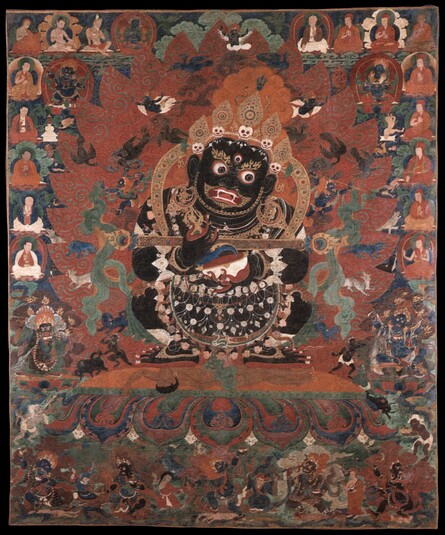
Item: Mahakala (Buddhist Protector) - Panjarnata (Lord of the Pavilion)
| Origin Location | Tibet |
|---|---|
| Date Range | 1400 - 1499 |
| Lineages | Sakya, Ngor (Sakya) and Buddhist |
| Material | Ground Mineral Pigment on Cotton |
| Collection | Publication: Art of the Himalayas |
| Painting School | Gyangtse |
Panjarnata Mahakala (Tibetan: gur gyi gon po, English: the Great Black One, Lord of the Pavilion). The Sanskrit word 'panjara' can mean a canopy, enclosure or pavilion. The source text for this form of Mahakala is the Dakini Vajra Panjara Tantra [Toh 419]. Some publications have chosen to use the English term 'tent' or 'cage' however these terms do not in any way help to understand the meaning and use of 'panjara' with reference to Mahakala or Buddhist Tantra in general.
Videos: - The Meaning of Panjara - Panjarnata Mahakala
With one face and two hands he holds a curved knife and skullcup to the heart with a 'gandhi' stick resting across the forearms. From this magical emanation stick all other forms of Mahakala emanate. His hair flames up like fire as he glares with round eyes and a gaping mouth. Very fierce with all the customary wrathful ornaments and attire such as the necklace of fifty freshly severed heads, tiger skin lower garment and a long snake as a Brahmin cord he also wears an ornate white scarf around the neck. In a squat posture he stands atop a corpse above a sun disc surrounded by a mass of flaming fire of pristine awareness. Emanating above, from the circle of fire are garuda birds and to the sides - wolves, black dogs, crows and a black man in front. These five types of beings are the messengers of Mahakala.
At the upper left side is Bhutadamara Vajrapani with one face and four hands standing atop a white daemon with four hands and the head of an elephant. Below that Kartaridhara Mahakala holds a curved knife aloft with the right hand and a skullcup to the heart with the left.
At the upper right side is Ekajati (Tib.: ral chig ma, Eng.: One Braid) with one face and two hands holding a vase to the heart, seated in a relaxed posture. Below that is Shri Devi (Tib.: pal den lha mo, Eng.: Glorious Goddess) with one face and four hands holding a sword and skullcup in the right and a spear and staff in the left; riding a donkey.
Directly below Mahakala is a row of five wrathful figures. These are the main attendants to Mahakala, a father and mother, Kala Rakshasa and Kali Rakshasi and their three offspring, Putra, Bhatra and Ekajati Rakshasi. They all have one face and two hands, and hold a variety of weapons. These eight deities, Mahakala, Ekajati, Shri Devi and the Five Rakshasa, form the famous 'Eight Deity Mahakala' of Sakya.
Lineage: Vajradhara, Vajrapanjara Dakini, Brahmin Vararuchi, Pandita Deva Vajra, Shraddha Karavarma, Lochen Rinchen Zangpo, Drag Tengpa Yontan Tsultrim, Mal Lotsawa Lodro Drag, Sachen Kunga Nyingpo (1092-1158), etc.
Jeff Watt 6-1998
Painting Style: Gyantse Scroll Paintings
Mahakala: Panjarnata Masterworks (Painting & Textile)
Mahakala: Panjarnata, Lord of the Pavilion (Main Page)
Collection of The Metropolitan Museum of Art: Main Page
Mahakala: Panjarnata Art History
Exhibition: Mandalas, Mapping the Buddhist Art of Tibet
Exhibition: Mandalas, Mapping the Buddhist Art of Tibet (Corrigendum)


